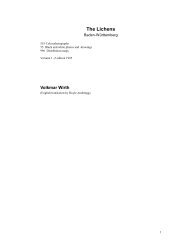Lichen communities in the British Isles: A preliminary conspectus
Lichen communities in the British Isles: A preliminary conspectus
Lichen communities in the British Isles: A preliminary conspectus
You also want an ePaper? Increase the reach of your titles
YUMPU automatically turns print PDFs into web optimized ePapers that Google loves.
334 P<br />
E.<br />
Caloplacetum mar<strong>in</strong>ae DR.<br />
W. James, D. L. Hawksworth and tr-. I?ose<br />
Mar<strong>in</strong>e and Maritiftie Cornrrtunities<br />
saensk. acixtstciol. stillsh. rlantll.2, s0 (192s) las "Caktplaca mar<strong>in</strong>a-Lss.,'f.<br />
'r'he caloplacetum mar<strong>in</strong>ae is <strong>the</strong> characteristic association of <strong>the</strong> sub-<br />
10. I.ichen Communities t'.n <strong>the</strong> <strong>British</strong> <strong>Isles</strong> 38s<br />
Frc. 11. Caloplacetunt rnar<strong>in</strong>ae on maritime siliceous rocks. Predom<strong>in</strong>ant species:<br />
Caloplaca mar<strong>in</strong>a, C. thall<strong>in</strong>cola and Verrucari,a mttura (Mid-Ebudes: Island of<br />
Mull, Ross of Mull, Carsaig Bay.1972, P. W. James).<br />
C. oerruculifera. Lecanora actophila and L. helicopis are faithful to <strong>the</strong><br />
association <strong>in</strong> <strong>the</strong> <strong>British</strong> <strong>Isles</strong>, <strong>the</strong> former tend<strong>in</strong>g to prefer more sunny,<br />
well lit situations. Verrucaria maura is often present (e.g. Fig. 11),<br />
espccially on more sheltered shores where it is often overgrown by<br />
Caloplaca thall<strong>in</strong>cola. In nor<strong>the</strong>rn and some western areas Arthonia<br />
phaeobaea and Lecania aipospila also form part of this association and may<br />
become locally abundant. Catillaria chalybeia and Lecania erysibe are<br />
often common although <strong>the</strong>se species, unlike <strong>the</strong> othcrs mentioned above,<br />
are by no means restricted to coastal rocks. Lich<strong>in</strong>a conf<strong>in</strong>is, occurr<strong>in</strong>g <strong>in</strong><br />
<strong>the</strong> lowest part of <strong>the</strong> mesic-supralittoral zone, forms a l<strong>in</strong>k with <strong>the</strong><br />
Verrucarietum maurae; similarly Xanthoria pariet<strong>in</strong>a, characteristic of <strong>the</strong><br />
submesic-supralittoral, <strong>in</strong>terconnects with <strong>the</strong> Ramal<strong>in</strong>etum scopularis<br />
association.<br />
A more nutrient-cnriched facies of this association, commonly <strong>in</strong>clud<strong>in</strong>g<br />
Aspicilia leprosescens, Caloplaca "^erruculifera, Lecanora poliophaea,<br />
R<strong>in</strong>od<strong>in</strong>a subexigua and <strong>the</strong> alga Prasiola quadrata occurs on birds' perch<strong>in</strong>g<br />
rocks along <strong>the</strong> shore or near nest<strong>in</strong>g sites. The rare Caloplaca scopularis,<br />
Candelariella arctica and Lecanora stram<strong>in</strong>ea may also occur <strong>in</strong> this<br />
community. The relationship between this facies ancl <strong>the</strong> Candelarielletun<br />
corallizae is noted on p. 378,





